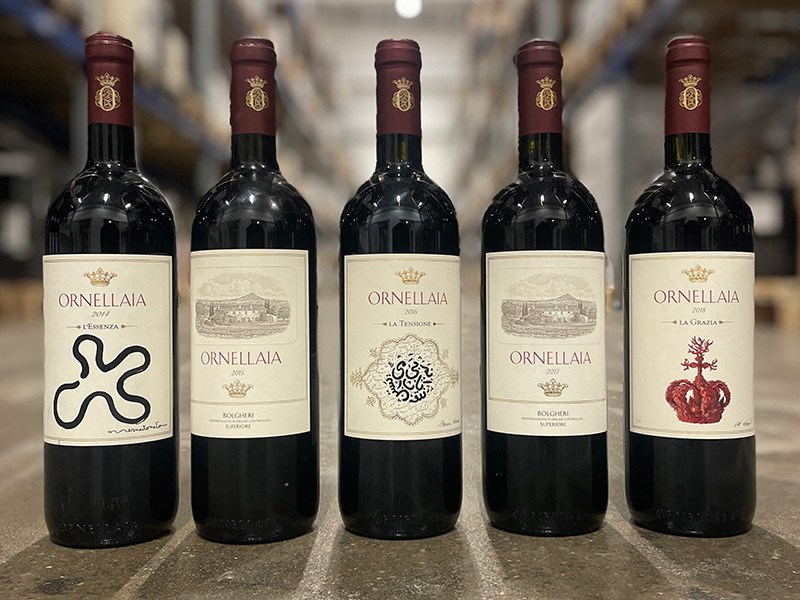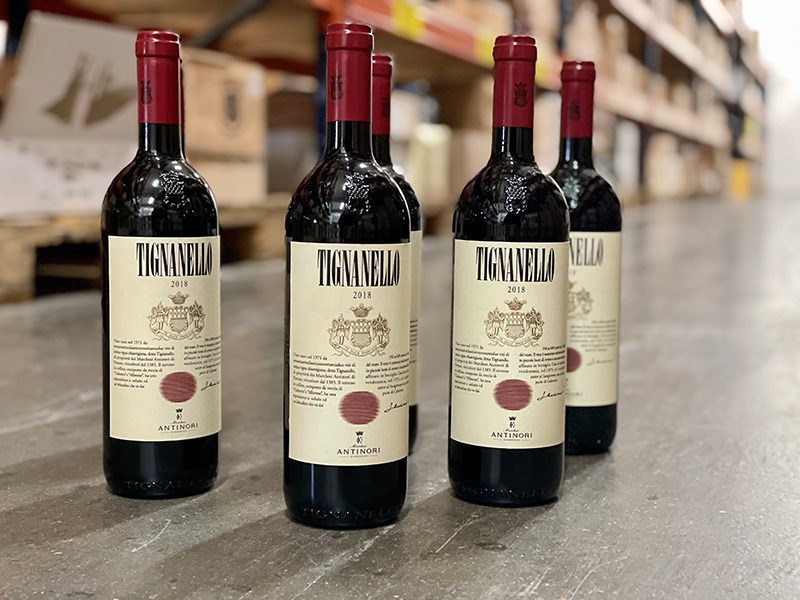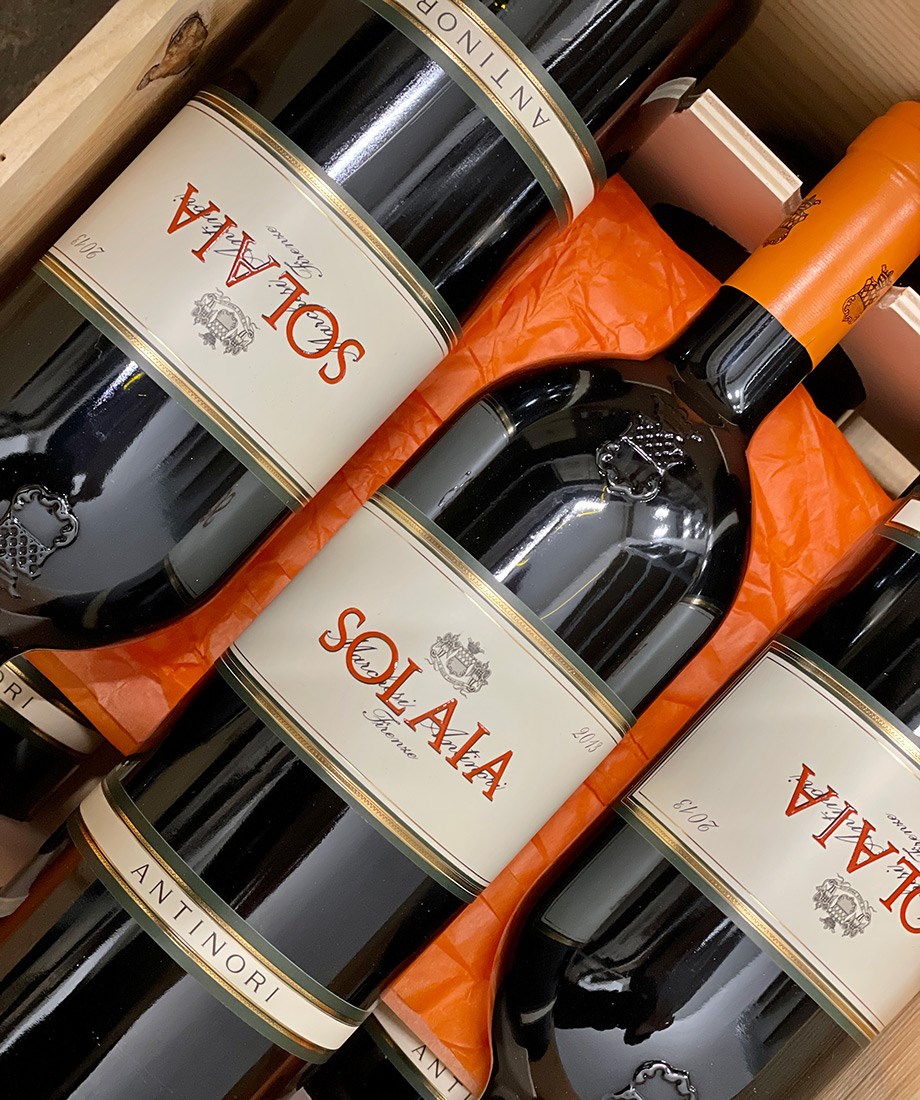Article - RareWine Academy
Marchesi Antinori - Italian Finesse For 26 Generations
World-famous signature wines such as Tignanello, Solaia and Guado al Tasso, inherited wine talent and successful shockwaves are some of the things that characterise Antinori
“Ancient family roots play an important part in our philosophy, but they have never hindered our innovative spirit”
- Piero Antinori
Marchesi Antinori is one of the most prestigious families in Italy, famous and notorious for their unshakable adherence to traditions that go back centuries. And at the same time, as Piero Antinori points out above, they do not let tradition stand in the way of innovation.
Marchesi Antinori has established a strong presence on the world's wine scene, and from generation to generation they have worked to maintain and develop the values, passion, and quality of the house. Their success is built on a curious approach - a curiosity about what the future holds in 10, 20 and 30 years. Tomorrow's wine trends, if you will.
”I always say it has taken a long time to build, but it takes a second to destroy everything”,
- Allessia Antinori
Curiosity is rooted in a solid foundation of experience, expertise, and quality, and while Marchesi Antinori is innovative, they leave nothing to chance. Dive into the story of the marvelous Marchesi Antinori, who have been refining their wines for centuries.
Marchesi Antinori - The Epitome Of Italian Finesse
Marchesi Antinori! It does not get much more Italian than that. Since the 18th century, the family has had the right to use the title "Marchesi/Marquis", which in Italy is a noble title that ranks above count and below prince. Rinuccio di Antinori is the first registered Antinori in history - registered as a winemaker from Castello do Combiate in Tuscany. Rinuccio's wines gained a good reputation in the late 12th century, but the family moved on to Florence and, for financial reasons, began to focus on silk weaving and banking instead.
Fortunately, the talent for wine was passed down through generations. In 1385, Giovanni di Piero Antinori became a member of the "Arte Fiorentina dei Vinattierie" - The Florentine Winemakers' Guide. This is where the family's wine history really began, although Rinuccio planted the first seed, and today Marchesi Antinori has made its mark on the international wine scene. Just as they made their mark on the Italian art scene and in literary circles.
The Antinori family has historically had a great influence in Italy - especially in Florence. Here you will find Palazzo Antinori, built between 1461 and 1469 and designed by Giuliano da Maiano. It was built under the name Palazzo Boni, but when Niccolò di Tommaso Antinori bought the building in 1506, Boni was of course replaced by Antinori. Niccolò di Tommaso Antinori was one of the most influential people in Florence at the time. Since then, several members of the Antinori family have lived at Palazzo Antinori over the years, using it as their headquarters.
It is also on the ground floor of Palazzo Antinori that Cantinetta Antinori has been located since 1957. Cantinetta Antinori is one of the most high-profile eateries in Florence, and the wine list naturally offers a large selection of wines from Marchesi Antinori's own vineyards. Palazzo Antinori is, according to the family's own statement, both a historical landmark and a symbol of old traditions and the continuous development of the family's own history. Not many companies can boast 6 centuries of experience - Marchesi Antinori can, and at the time of writing they are the 10th oldest owned company in the world.

Niccolò Antinori And Guado al Tasso
When Antinori's recent history unfolds, it is Niccoló and his descendants that are mentioned in particular - and this is of course because they have had the greatest influence on the house's worldwide success in recent times. In 1928, Niccoló made his first Chianti - he wanted to create a high-quality wine that could be stored and improve over time - and so Villa Antinori Rosso became a reality - and the idea that Chianti could be aged and evolve was a new idea at the time.
In 1931, Niccolò Antinori married Carlotta Della Gherardesca, and as a marriage gift she received the piece of land in Bolgheri that the world knows today as the Guado al Tasso Estate. The family decided to advance viticulture here, and today Guado al Tasso is a major international reference point for very high quality wine.
Niccolò was honoured in 1952 with the title of Cavaliere del Lavoro, and in 1995 Piero Antinori received the same honour as his father. It is a prestigious recognition awarded to Italian citizens who have achieved outstanding achievements in agriculture, industry, trade or craftsmanship.
Marchesi Piero Antinori: Fra Air Force Til Antinori CEO
In 1966, Niccolò retired and handed Marchesi Antiniori over to his eldest son Piero, aged just 28. But actually, this was never Piero's original plan. He was preparing to join the Italian Air Force when his father called for assistance.
The Arno River had overflowed its banks and the streets of Florence were reluctantly taking the flood waters - even the basement of Antinori's headquarters did not escape the flooding either, and the flood waters destroyed hundreds of precious bottles. But actually, a natural disaster was the least of the problems.
Antinori's customers became ill, and the illness could be traced to an incorrect chemical that had accidentally been used as a preservative in a batch of the house's wines. Naturally, this led to wine recalls and unhappy and uncertain customers. Niccolò took full responsibility and decided to resign so that the company could make a fresh start - with a new Antinori at the helm.
And so it happened that Piero had to take over the baton from his father and forget his dream of joining the Italian Air Force. A decision Piero has never regretted.
Tignanello Sent Shockwaves Through The Entire Country
Piero started his new position by rebuilding trust between Antinori and its customers - successfully. And because Piero has an instinct and perhaps even an inherited drive for innovation, soon after damage control he began experimenting with malolactic fermentation. Here he realised that the traditional Tuscan method "Governo all'Uso Toscano" with a secondary fermentation to reduce acidity levels became redundant if malolactic fermentation was used.
And it was with this discovery that Piero really disrupted the conventions of winemaking in Italy. In 1971, he and the house oenologist Giacomo Tachis created the iconic Tignanello - precisely through malolactic fermentation and ageing in French oak barriques.
In 1975, they went one step further when they added Bordeaux varieties and removed the green grapes from the blend. Green grapes that were necessary to obtain the Chianti Classico designation.
It was the first Sangiovese wine to be aged in barriques. It was the first red wine to be blended with unconventional, and in some people's eyes forbidden, foreign varieties, and the first wine in Chianti Classico not to contain green grapes. There was an uproar in the country but Tignanello became a turning point for Italian winemaking, and Tignanello is today recognised as one of the first so-called Super Tuscans - albeit not the first, as Sassicaia triumphantly took that title.

Victorious lineage: Sassicaia, Ornellaia, and Masseto
Piero’s aunt inherited a large estate near Bolgheri. She was also married to a Francophile nobleman named Mario Incisa della Rochetta, who had a particular love for the wines of Bordeaux. So, it was natural for the couple to plant French Cabernet Sauvignon in the inherited vineyards, which were ideal for the unconventional grape but ideal for creating French wines for their own consumption. They named the wine Sassicaia, and in 1968, de Piero was asked to market Sassicaia.
He was determined to do so, and it remained that way until Mario died 15 years later, after which his son took over the management. A virtually unknown wine region in Italy had managed to make Bordeaux-inspired wine that gave Bordeaux wines a run for their money...
... Sassicaia also has a prominent neighbour. The name is Ornellaia, whose top wine is named after the house. The first Ornellaia was presented in 1985, and the founder Lodovico is the nephew of Mario Incisa della Rocchetta. Lodovico's surname is Antinori and his brother is Piero. Ornellaia is today one of the most respected wineries in Tuscany. And even though Lodovico sold Ornellaia to Napa Valley star Robert Mondavi in 2002 (and then to the Frescobaldi family in 2005), it is still remarkable that an Italian family is branching out and spreading exclusive wine magic to multiple destinations.
Furthermore: In consultation with André Tchelitscheff, Lodovico Antinori intuitively decided to plant Merlot vines on his clayey Masseto plot. And his intuition paid off. Masseto is another Super Tuscan success story that has today gained cult status among the world's wine lovers - when the 100 points first came to 2001 Masseto from James Suckling.
And Then Came Solaia - Antinori's Other Superstar
There is no doubt that Antinori's absolute signature wines are Tignanello and Solaia, which come from vineyards on the same hillside. They are both described as among the most influential wines in Italian wine history.
Solaia first saw the light of day in 1978, and upon first release it contained 80% Cabernet Sauvignon and 20% Cabernet Franc - later Sangiovese was also introduced to the Solaia blend. In 2000, the 1997 Solaia was named Wine of the Year by Wine Spectator, making headlines across the wine world and generating massive interest. Piero Antinori's success as a result of paying homage to the traditions of Chianti Classico became an inspiration for other Italian winemakers and more began to experiment.

There Came One, There Came Two, There Came ....
Success rarely comes overnight, and behind Antinori's colourful success story lies great adversity, massive amounts of diligence and, of course, an inherited business sense that has paid off on several occasions. Of course, the key to success also lies in being innovative and always staying one step ahead of the competition.
Antinori is originally based in Chianti, but this has not limited their horizons and over the years they have expanded their territory with several properties in Montepulciano, Bolgheri, Maremma Tuscany, Cortona and Montalcino. In Piedmont they are behind Prunotto and Tenuta Montenisa. In Umbria with Castello della Sala and in Puglia with Tormaresca. But why keep it within Italy's borders? Antinori has also acquired Antica in Napa Valley, Col Solare in Washington, Stag's Leap Wine Cellars in Napa Valley, Haras de Pirque in Chile's Maipo Valley - and more.
Get the full overview of Antinori's properties and wines here.
Another Break With Tradition
For many years in Italy, there was a tradition of a winery being passed down to male heirs. Piero Antinori had three daughters, and because he did not think they would be interested in taking over the family domain, in 1981 he sold a share of the Antinori dynasty to a UK-based brewing company. It was not until ten years later that Piero Antinori realised that his daughters actually shared his passion for winemaking, so he decided to buy back his shares and break the male legacy tradition.
Antinori For 26 Generations
Today, Albiera, Allegra and Alessia Antinori head the Antinori family business, representing the 26th generation. According to Alessia, the DNA of the house is a unique blend of Tuscan traditions dating back centuries, as well as a strong focus on embracing and incorporating modern innovation into their winemaking. All three daughters play an important role today, each of them pursuing some of the house's individual interests that together make up the essence of Antinori.
The three girls became involved in the business from a very early age - especially when it came to harvesting the grapes. And the youngest sister Alessia felt very drawn to the world of wine - so much so that she studied oenology, food science and technology at the Agrarian University in Milan. Allesia also has a massive interest in modern art, which is why she also conceived the Antinori Art project, which invites artists to create artworks with a location-specific starting point. These include themes such as nature, wine, history, tradition, and innovation, all of which are intrinsic to Antinori. The works are exhibited at the company's headquarters.
Furthermore, she spent a lot of time advancing her knowledge of export and sales, which is why she spent several months a year for a number of years in Asia and India as an Antinori ambassador. She also lived in New York, where she was an integral part of Antinori's sales team.
The second eldest daughter Allegra runs the family's restaurants and cookery schools, and she travels extensively to Moscow, Vienna, Zurich and Monte Carlo to check out the Cantinetta Antinori restaurants.
Albiera is the eldest sister and president of the company. Together with her sisters and the house's chief winemaker Renzo Cotarella, she manages the family's properties, which are mainly located in Tuscany and Umbria.
Architectural Gem In Chianti Classico - The New Winery
In 2012, after 7 years of construction, Antinori finally inaugurated their new winery. A winery designed to welcome passionate wine lovers who want to get an insight into the stages of wine production, Antinori's rich history, architecture at its finest and culinary experiences. It is an impressive building that pays tribute to a family rich in tradition - there is even a cinema where a film of the family's history is told. A large part of the family's art collection was even moved to Chianti Classico from Palazzo Antinori - so that guests would also be able to enjoy it.
There is no doubt that the new winery and headquarters is where Antinori's future lies. The architectural, innovative gem is an amalgamation of everything the family stands for. The winery is nestled between olive groves and vineyards that cover the building, making it almost invisible to the naked eye. Three floors of breathtaking architecture greet the visitor, and a spectacular spiral staircase steals the eye. At the top of the building is Rinuccio 1180 - a restaurant that represents Chianti's very best cuisine, accompanied by Antinori's wines, of course.
There is no equal to Antinori nel Chanti Classico, and this is entirely consistent with Piero Antinori's statement in his memoir The Hills of Chianti, where he says "Grow. Learn. Improve."
Marchesi Antinori: ”The World’s Most Admired Wine Brands”
In March 2023, Drinks International released their ranking of the world's most admirable wine brands in the world, and Marchesi Antinori came out on top. The ranking was decided by an academy of Masters of Wine, sommeliers, buyers, journalists and industry experts from around the world.
The starting point for assessment was based on which five wine brands the judges admire the most: based on quality, consistency, price and quality ratio, and brand strength. Marchesi Antinori was named the winner, mainly due to high quality that does not decline over time. Antinori is the first Italian winery to top the list - a list that also includes wineries such as Domanie de la Romanée-Conti, Penfolds, Sassicaia and Petrus.
Antinori has been around for hundreds of years, and as a newly recognised global brand, they prove that they, more than anyone else, are able to innovate decade after decade - generation after generation.
